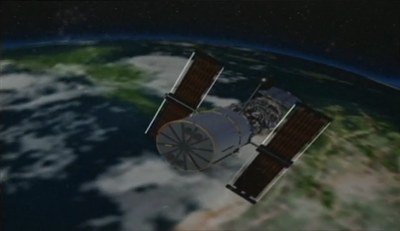Review: Saving Hubbleby Jeff Foust
|
| The film features interviews with some of the scientists and engineers involved with Hubble and journalists who covered it, but it also includes a broad cross-section of the public as well, talking about Hubble and what it means to them. |
That public outcry over a “death sentence” for Hubble is the subject of Saving Hubble, a documentary directed by David Gaynes currently being screened at a handful of events, including at the 219th meeting of the American Astronomical Society (AAS) in Austin, Texas, earlier this month. This film is hardly the first documentary about the Hubble, but unlike some previous ones, like Hubble 3D (see “Review: Hubble 3D”, The Space Review, March 22, 2010), the focus is less about the telescope itself or its scientific discoveries than its impact on the public. “The film shows what Hubble says about us,” Gaynes said at the AAS meeting screening.
Saving Hubble does provide some history about the telescope, charting the highs and lows, such as the reaction to its optical aberration discovered shortly after launch to the successful repairs of the telescope and the imagery it’s produced. The bulk of the film, though, is about the decision by then-NASA administrator Sean O’Keefe to cancel the final Hubble servicing mission, and the reaction by both astronomers and the public. The film features interviews with some of the scientists and engineers involved with Hubble and journalists who covered it, but it also includes a broad cross-section of the public as well, talking about Hubble and what it means to them. Gaynes casts a wide net here, from a gregarious taxicab driver in Nashville to high school athletes and cheerleaders in Kansas to even the commercial spaceflight pioneers working at Mojave Air and Space Port in California. (There’s an unexpected cameo in the film by NewSpace company XCOR Aerospace, talking about how companies like it are making space more accessible to the public; the scenes were apparently filmed several years ago since the company was showing off a model of its Xerus suborbital spaceplane concept, which has since been superseded by the Lynx.)
Saving Hubble has a villain and, not surprisingly, it’s O’Keefe, who is portrayed as a “beancounter” unwilling to accept the risks of sending a shuttle to Hubble with no prospect of rescue should it be unable to safely return to Earth. O’Keefe appears in the film in a series of clips from speeches and press conferences from his tenure as NASA administrator, but the documentary doesn’t give O’Keefe a later opportunity to explain his decision. Gaynes explained after the AAS screening that he did speak with O’Keefe while working on the film, talking to O’Keefe by phone during his time as chancellor of LSU, but decided not to film an interview with him for the documentary. “I’m not sure what we would have gotten from it that wasn’t captured in the material that was already presented,” Gaynes said. He admitted that O’Keefe’s portrayal was not “100% positive” but that it was fair.
Gaynes said that the movie will be available on DVD later this year, but his focus for now is arranging a series of screenings called the “Hubble Roadshow”, which will combine the film with lectures by astronomers as well as star parties. “We want the film to create actionable events around the country where the film can be paired with amateur astronomy, talks and discussions with professional scientists, all in an effort to foster a greater interest in science among the public and a connection between the public and the professional community,” he explained. If efforts like that are successful, the resulting greater public interest in science in general and astronomy in particular could become the greatest legacy of the Hubble Space Telescope.
